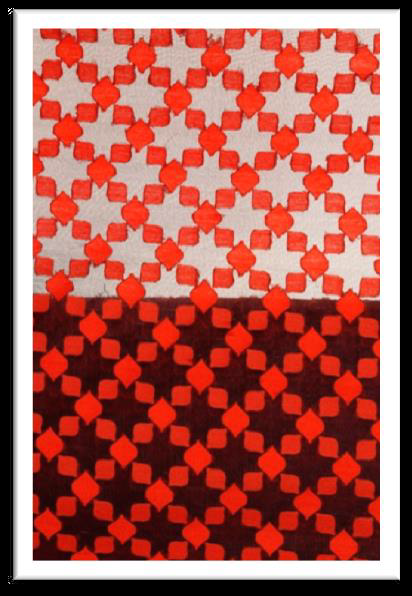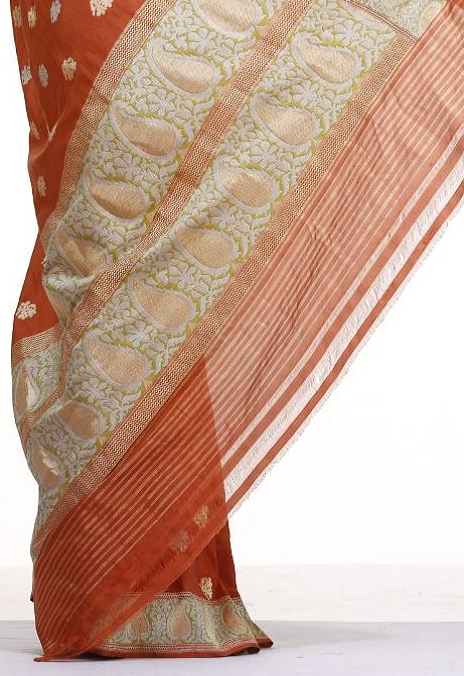Banaras Cutwork Fabric and Silk Saree
Banaras Cutwork Fabric and Silk Saree
Banarasi Cutwork Fabric
Background
Banaras or Kashi is known for holy pilgrimage. It is equally known for exquisite handwoven silks apart from many other handicarfts and music. By the early 19th century, Benaras had emerged as the most important centre for patterned silk weaving in the subcontinent. Banarasi cutwork fabric is produced by clipping the extra floating threads which are not engaged in design formation and lying loose in the back side of the fabric. It is an attempt to imitate the look of the designing of highly labour intensive ‘Karhuwa’ technique and produce low cost fabrics in bigger quantity.

Material used
The materials used for weaving of Cutwork fabric are twisted silk yarn in warp and weft for base fabric and for figuring silk yarn, zari or both silk and zari.
Techniques applied
Cutwork fabrics are woven on traditional throw shuttle pitloom with the attachment of jacquard or jala, pagia and naka. Designs are created by using extra weft yarn. In this fabric, designing is done with continous extra weft thread instead of using many short length threads as done in Karhuwa technique. Unwanted loose threads floating between two motifs are clipped with the scissors after weaving leaving the base fabric open.
How to distinguish Cutwork Fabric
- It can easily be identified by viewing cutting edges of extra weft threads at back side of the fabric.
- There will be no clean outer edge of the designs.
- Since design thread are cut from both sides, the same may be taken out easily from the fabric with the help of a pin.
Banarasi Cutwork Silk Saree
Background
Banaras or Kashi is known for holy pilgrimage. It is equally known for exquisite handwoven silks apart from many other handicarfts and music. By the early 19th century, Banaras had emerged as the most important centre for patterned silk weaving in the subcontinent. Banarasi cutwork fabric is produced by clipping the extra floating threads which are not engaged in design formation and lying loose in the back side of the fabric. It is an attempt to imitate the look of the designing of highly labour intensive ‘Karhuwa’ technique and produce low cost fabrics in bigger quantity.

Material used
The materials used for weaving of Cutwork Silk Saree are twisted silk yarn in warp and weft for base fabric and for figuring silk yarn, zari or both silk and zari.
Techniques applied
Cutwork Silk Sarees are woven on traditional throw shuttle pitloom with the attachment of jacquard or jala, pagia and naka. Designs are created by using extra weft yarn. In this fabric, designing is done with continuous extra weft thread instead of using many short length threads as done in Karhuwa technique. Unwanted loose threads floating between two motifs are clipped with the scissors after weaving leaving the base fabric open.
How to distinguish Cutwork Silk Saree
- It can easily be identified by viewing cutting edges of extra weft threads at back side of the fabric.
- There will be no clean outer edge of the designs.
- Since design threads are cut from both sides, the same may be taken out easily from the fabric with the help of a pin.
Source : Indian Handloom Brand
Last Modified : 9/4/2023
This topic provides information about Tussar Gichh...
This topic provides information about Arni Silk Sa...
This topic provides information about Tweed.
This topic provides information about Kani Pashmin...
